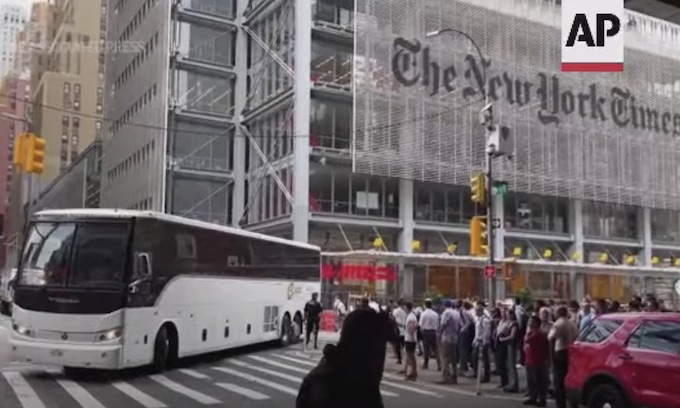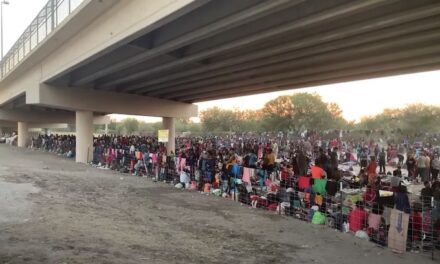Around 7,600 migrants have poured into New York over the last several weeks — many on buses from Texas courtesy of Gov. Greg Abbott — straining an already-shaky social service network.
The buses often show up with no warning, forcing the city and social service providers to scramble to provide aid. There is no indication how many more are coming, or when the influx might slow.
Here’s a look at how the city is handling the wave of new arrivals — and when the city’s already overflowing shelter system might reach a breaking point.
How many migrants have come to New York so far?
With migrants from South America crossing the U.S. Southern border in record numbers, roughly 7,600 asylum seekers have cycled through the shelter system since this spring, according to Mayor Eric Adams. Around 5,700 migrants are reportedly still in the system.
Of those, about 1,500 asylum seekers have arrived on the buses from Abbott, according to the New York Immigration Coalition. As a sanctuary city, New York is an attractive destination for those arriving in the country with few resources.
How many more are coming?
Nobody knows.
What we do know: The buses from Texas aren’t slowing down, and show no signs of stopping. While some of the first buses came with just dozens of asylum seekers, now, hundreds of migrants arrive near-daily.
“In the early days, there were like one or two buses that didn’t have many people on them,” Murad Awawdeh, executive director of New York Immigration Coalition, said. “Now, there are buses that are packed with folks coming to New York City.”
The arrivals are very unpredictable.
“Anytime we start feeling like we’ve settled into a pattern, it shifts,” Ilze Thielmann, the director of Team TLC, who receives back-channel notice of buses arriving said. “…They want to keep us on our back foot as much as possible.”
What happens when they arrive?
When a bus full of migrants pulls into Port Authority, groups such as Grannies Respond, Team TLC NYC and South Bronx Mutual Aid working on the ground, as well as the Mayor’s Office on Immigrant Affairs, race to meet them. They provide legal services, medical attention, clothing, food, masks and transportation to shelter as the migrants step off the bus.
Many of the migrants never intended to stay in New York: Around a third of the migrants came to New York against their will, according to Awawdeh, and leave almost immediately. The groups help them secure tickets to their original destination.
For migrants who do plan on staying, groups work to help migrants look for jobs, directing them to day laborer centers. While asylum seekers are able to work in the U.S., they first need to meet with a lawyer – and with the ongoing staffing issues, this has been a challenge.
How is the city handling the influx?
To triage the problem, Mayor Adams has focused on expanding shelter capacity. The city’s “right to shelter” law requires the city to find shelter for anyone requesting it, regardless of immigration status, but shelters — already near capacity as the city’s homeless population swells — don’t have enough empty beds to accommodate the new arrivals.
The city has said it plans to open an intake and processing center specifically for the asylum seekers, but recently pushed back the full-scale opening.
“We did a soft opening. We want to make sure it’s right. We don’t want to just do something expeditiously that’s not going to be as successful,” Adams told reporters Monday.
For now, the city is focused on more expedient alternatives, housing migrants in more than a dozen hotels across the city, including one that in upper Manhattan that began housing migrants Monday.
Shaun Abreu, City Council representative for District 7, where the hotel is located, celebrated the opening of the temporary new digs for 30 families with 20 school-age children.
“I think that’s going to make a huge difference in making sure that existing shelter capacity is where it needs for current unhoused residents, while expanding the use of the private sector particularly with these hotels to be able to withstand the influxes coming in,” Abreu said.
How is this affecting an already strained system?
New York’s shelter system is simply not set up to handle this kind of rapid influx.
“By getting these people who don’t have documentation, don’t speak the language, don’t know their way around the city, don’t know all the things that you need to be able to do to navigate the shelter system in New York City,” Thielmann said. “They can’t do it. And so they’re really struggling.”
But the influx of migrants is not the only factor straining the system. After the statewide pandemic eviction moratorium ended in January, evictions are ticking up. Rising rent prices also mean more people are at risk of homelessness. On top of that, homelessness among families with children usually surges in the warmer months, Kathryn Kliff, attorney with the Legal Aid Society said.
According to the most recent Department of Social Services tally, there are more than 52,000 homeless people in the city — a sharp increase from even a decade ago. The city’s shrinking shelter vacancy rate recently rested under one percent.
All of this adds up to a dire shortage of beds — and questions about whether the system will be able to keep pace. The city in July violated the Right to Shelter law, which requires finding a place to stay for anyone arriving by 10 p.m. looking for one.
As the city continues to wrestle with rapidly increasing demand and strain on the system, advocates fear additional violations or other problems.
Limited paths out of the shelter system place further pressure on the system, feeding into a cycle. The only sure way to end the cycle of crises, they say, is developing a better network of housing options.
“With a lack of affordable housing and permanent housing for folks, the shelter system is, in this way, this temporary place where people end up being for a pretty long time,” Awawdeh said.
How long is this going to continue?
Indefinitely. Some hope that the pressure from Abbott will let up when the midterm elections pass in November, although others are less optimistic.
“I think that we will probably continue to see buses coming into the city beyond the midterm elections unless [Abbott] gets beaten in the upcoming Texas gubernatorial election,” said Awawdeh.
“I think it is trying to give is trying to give Democrats a bad name, but, you know, Republicans rarely tire of that. So maybe the fun will continue after the midterms,” said Thielmann.
©2022 New York Daily News. Visit nydailynews.com. Distributed by Tribune Content Agency, LLC.
—-
This content is published through a licensing agreement with Acquire Media using its NewsEdge technology.



















“Sanctuary City Claims Thousands Of Migrants Pouring In From Texas Straining Shelter System”
No One forced these cities to abandon and break the immigration laws and claim that they are Sanctuary Cities for the Illegal immigrants.
So Stop Whining, You ask for it!
BUT YET WHEN conservative mayors and governors COMPLAINED After the FEDS FLEW illegals in, and just DUMPED THEM ON OUR TOWNS, often in the dark of night, we were called RACIST FOR DARING TO criticize it…
They complain about a few thousand illegals, what would they do if they had to put up with hundreds of thousand a month? These left wingers are nothing but a phony bunch of complainers that only worry about their own wealth and well being.
They’re ok with it, AS LONG AS IT is other folks having to deal with the issue.
The buses often show up with no warning, forcing the city and social service providers to scramble to provide aid. There is no indication how many more are coming, or when the influx might slow.
Funny how that happens when you leave the borders wide open.
Sanctuary cities were to be the beacon for the rejected, the aliens, the forgotten, the homeless, the druggies, they shoould have been prepared for the onslaught or were they just empty words to make them sound compassionate? Has their hearts hardened?